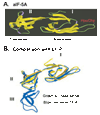The post-translational synthesis of a polyamine-derived amino acid, hypusine, in the eukaryotic translation initiation factor 5A (eIF5A)
- PMID: 16452303
- PMCID: PMC2494880
- DOI: 10.1093/jb/mvj034
The post-translational synthesis of a polyamine-derived amino acid, hypusine, in the eukaryotic translation initiation factor 5A (eIF5A)
Abstract
The eukaryotic translation initiation factor 5A (eIF5A) is the only cellular protein that contains the unique polyamine-derived amino acid, hypusine [Nepsilon-(4-amino-2-hydroxybutyl)lysine]. Hypusine is formed in eIF5A by a novel post-translational modification reaction that involves two enzymatic steps. In the first step, deoxyhypusine synthase catalyzes the cleavage of the polyamine spermidine and transfer of its 4-aminobutyl moiety to the epsilon-amino group of one specific lysine residue of the eIF5A precursor to form a deoxyhypusine intermediate. In the second step, deoxyhypusine hydroxylase converts the deoxyhypusine-containing intermediate to the hypusine-containing mature eIF5A. The structure and mechanism of deoxyhypusine synthase have been extensively characterized. Deoxyhypusine hydroxylase is a HEAT-repeat protein with a symmetrical superhelical structure consisting of 8 helical hairpins (HEAT motifs). It is a novel metalloenzyme containing tightly bound iron at the active sites. Four strictly conserved His-Glu pairs were identified as iron coordination sites. The structural fold of deoxyhypusine hydroxylase is entirely different from those of the other known protein hydroxylases such as prolyl 4-hydroxylase and lysyl hydroxylases. The eIF5A protein and deoxyhypusine/hypusine modification are essential for eukaryotic cell proliferation. Thus, hypusine synthesis represents the most specific protein modification known to date, and presents a novel target for intervention in mammalian cell proliferation.
Figures





Similar articles
-
Posttranslational synthesis of hypusine: evolutionary progression and specificity of the hypusine modification.Amino Acids. 2007 Aug;33(2):341-50. doi: 10.1007/s00726-007-0525-0. Epub 2007 May 4. Amino Acids. 2007. PMID: 17476569 Free PMC article. Review.
-
Production of active recombinant eIF5A: reconstitution in E.coli of eukaryotic hypusine modification of eIF5A by its coexpression with modifying enzymes.Protein Eng Des Sel. 2011 Mar;24(3):301-9. doi: 10.1093/protein/gzq110. Epub 2010 Dec 2. Protein Eng Des Sel. 2011. PMID: 21131325 Free PMC article.
-
Post-translational formation of hypusine in eIF5A: implications in human neurodevelopment.Amino Acids. 2022 Apr;54(4):485-499. doi: 10.1007/s00726-021-03023-6. Epub 2021 Jul 17. Amino Acids. 2022. PMID: 34273022 Free PMC article. Review.
-
Specificity of the deoxyhypusine hydroxylase-eukaryotic translation initiation factor (eIF5A) interaction: identification of amino acid residues of the enzyme required for binding of its substrate, deoxyhypusine-containing eIF5A.J Biol Chem. 2007 Mar 16;282(11):8300-8. doi: 10.1074/jbc.M607495200. Epub 2007 Jan 9. J Biol Chem. 2007. PMID: 17213197 Free PMC article.
-
Molecular cloning, expression, and structural prediction of deoxyhypusine hydroxylase: a HEAT-repeat-containing metalloenzyme.Proc Natl Acad Sci U S A. 2006 Jan 3;103(1):51-6. doi: 10.1073/pnas.0509348102. Epub 2005 Dec 21. Proc Natl Acad Sci U S A. 2006. PMID: 16371467 Free PMC article.
Cited by
-
A Translational Regulatory Mechanism Mediated by Hypusinated Eukaryotic Initiation Factor 5A Facilitates β-Cell Identity and Function.Diabetes. 2024 Mar 1;73(3):461-473. doi: 10.2337/db23-0148. Diabetes. 2024. PMID: 38055903 Free PMC article.
-
Biochemical quantitation of the eIF5A hypusination in Arabidopsis thaliana uncovers ABA-dependent regulation.Front Plant Sci. 2014 May 16;5:202. doi: 10.3389/fpls.2014.00202. eCollection 2014. Front Plant Sci. 2014. PMID: 24904603 Free PMC article.
-
Evidence for conformational changes in the yeast deoxyhypusine hydroxylase Lia1 upon iron displacement from its active site.Amino Acids. 2010 Feb;38(2):479-90. doi: 10.1007/s00726-009-0407-8. Epub 2009 Dec 3. Amino Acids. 2010. PMID: 19956996 Free PMC article.
-
Assay of deoxyhypusine hydroxylase activity.Methods Mol Biol. 2011;720:207-16. doi: 10.1007/978-1-61779-034-8_13. Methods Mol Biol. 2011. PMID: 21318876 Free PMC article.
-
A new non-radioactive deoxyhypusine synthase assay adaptable to high throughput screening.Amino Acids. 2017 Nov;49(11):1793-1804. doi: 10.1007/s00726-017-2477-3. Epub 2017 Aug 17. Amino Acids. 2017. PMID: 28819816 Free PMC article.
References
-
- Park MH, Lee YB, Joe YA. Hypusine is essential for eukaryotic cell proliferation. Biol. Signals. 1997;6:115–123. - PubMed
-
- Chen KY, Liu AY. Biochemistry and function of hypusine formation on eukaryotic initiation factor 5A. Biol. Signals. 1997;6:105–109. - PubMed
-
- Shiba T, Mizote H, Kaneko T, Nakajima T, Kakimoto Y. Hypusine, a new amino acid occurring in bovine brain. Isolation and structural determination. Biochim. Biophys. Acta. 1971;244:523–531. - PubMed
Publication types
MeSH terms
Substances
Grants and funding
LinkOut - more resources
Full Text Sources
Other Literature Sources
Molecular Biology Databases

